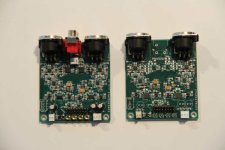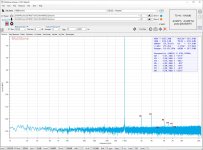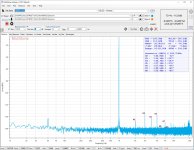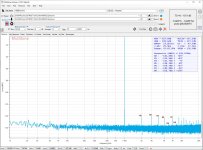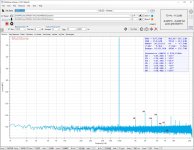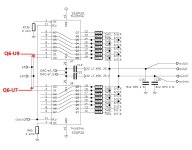I agree, pls revert to original and test this case before changing out resistors to foil types.Mark,
Fully understanding and appreciating your aiming for the best possible sound, but I can’t remember you ever tried Fifo PLUS buffer/reclocker but WITHOUT Se/Diff in NON RTZ mode, and letting Marcel’s board do the clock doubling and RTZ logic, am I correct ?
The way the shift registers are being fed now have too little ressemblance with the original design to make any possible SQ judgement on Marcel’s clever digital design.
Hans
At least in order to trust anyone about SQ I would have to sit in the same room and having listened and discussed the sound of that particular system - in that way one get a common ground for later exchange of SQ impressions that would mean something. It probably takes more than one session, but hey.... 🙂
//
//
Interestingly, I asked you something similar in another thread and you sort of stormed off. Can present some evidence, e.g. measurements, listening tests etc to compare?As I have made and listened to both I'm sorry to say that ES9039Q2M is not better sounding.
I don't think it makes sense for me to agree to that. Redoing all the changes again after that to see what the resistors actually do would be a lot of useless work. Putting super resistors in a flawed dac would be like trying to make a silk purse out of a sows ear (sorry Marcel for saying that, just trying to get through to Acko is all, the dac is a lot better than the analogy suggests). What I would agree to is to replace the resistors, see how it sounds under the best of conditions, then revert the dac to full original. Much of the resistor change benefits will be masked, but then I don't care. I will have already learned what I want to know.I agree, pls revert to original and test this case before changing out resistors to foil types.
Last edited:
Acko, I will contact you a bit later offline to discuss further details and your exact preferences for the final state of the dac.
But if more people experience similarly in different locations? Like Lambos and TeslasAt least in order to trust anyone about SQ I would have to sit in the same room and having listened and discussed the sound of that particular system - in that way one get a common ground for later exchange of SQ impressions that would mean something. It probably takes more than one session, but hey.... 🙂
//
Acko, that makes no sese IMO. You can only listen to the RTZ in combination with other equipment. Whether you under-drive the amp or add in a gain stage are just different compromises in the overall system context. If you're not prepared to take steps to accomodate the RTZ, I don't get your interest in it?This DAC does not match my Amp going direct. Output is too low 2V rms. Amp needs 9V rms. This may appear to sound less favourable compared to the other DACs that I have. So one of the reasons why I thought getting feedback from others with compatible systems would be better.
Without any direct experience I don't believe you have any good reliable information on which to form any opinion about the performance of the RTZ in any of its states.
FWIW I'm currently working on projects to build a Nelso pass Sony VFET power buffer and Ben Mah's Tokin THF-51S power follower, both of which will require lots of gain to be able to use them with any of my DSD decoders so I'm also exploring suitable gain/preamp arrangements - that's the way it is.
Last edited:
I already posted a measurement of my ES9039Q2M board in that thread. Other than that I have no reason to pollute this thread with ES9039Q2M stuff.Interestingly, I asked you something similar in another thread and you sort of stormed off. Can present some evidence, e.g. measurements, listening tests etc to compare?
Here is a picture of the board next to my earlier ES9038Q2M board. To make it apples to apples comparison I made the ES9039Q2M board more or less identical. However I discovered that simple dual mono scheme by paralleling dac chips as in ES9038Q2M does not work with ES9039Q2M so I have used only 1 channel from each chip. That is why I'll later replace the board with single chip version.
Attachments
Last edited:
I wonder how much jitter can be produced by his XOR that is driven by your super stable OCXO Fifo’s external crystal clock.
Maybe Marcel can comment on that.
The EXOR will add something to the phase noise floor and it will have 1/f noise that will affect the rising and falling edges in opposite directions, but as the EXOR phase noise/jitter is not specified and as I don't have the equipment to measure phase noise or jitter at home, I can't answer your question.
All I can say is that there will be no effect on the close-in phase noise at very small frequency offsets and that by design, the circuit with the EXOR has less impact on the rising edges that clock the shift registers than on the falling edges that don't clock anything. That's because the slow edges coming out of the RC filter only determine the falling edges at the EXOR output.
DIY Audio is a hobby to me and I'll always be indebted to people like Marcel, Nelson and the like who make it possible to for me to benefit from their skills and experience but at the end of the day I do it for fun and personal satisfaction. I've been happy to administer group buys on a couple of occassions, which take more time than you imagine, but I have learned a lesson with the RTZ builds and will not be expending my time doing builds for others in the future - life is too short, and my other interests suffer, so it simply isn't worth it regardless of any money.This is a DAC that is worth pursuing further. In fact if you wish to I am happy to cover the build costs for the units that you were planning to do by yourself. If it is too tedious as you explained why not get factory to do it for you. How much will it cost and let me know? I have spent heaps for EES and AKM so why not do the same for something more deserving here.
Please let me know.
Of course, with Marcel's agreement, you could get some RTZ boards factory assembled and I imagine you're far better placed to arrange that than I am.
It's not an area of expertise for me, but I believe there will be work required to facilitate factory assembly as I know Marcel uses an old version of KiCAD to produce his gerber files and I don't believe there are any pick and place files. Then, of course, there would could be other board mods required to accomodate any changes you might wish to incorporate, though deciding which would be worthy is going to be an interesting exercise based on the available data.
Hi Mark,
Its your obvious decision to proceed with your current setup, driving the shift registers with an external clock.
As a next step you have planned to change the resistors.
But before doing that, you could still try a very simple change, by changing the 4x4 shiftregisters into 2x8.
That takes only 2 wires, output from one shiftregister as input to the other.
An idea worth testing ?
Hans
Its your obvious decision to proceed with your current setup, driving the shift registers with an external clock.
As a next step you have planned to change the resistors.
But before doing that, you could still try a very simple change, by changing the 4x4 shiftregisters into 2x8.
That takes only 2 wires, output from one shiftregister as input to the other.
An idea worth testing ?
Hans
I am impressed by your creations, thank you. Yes, these are some of details that are useful. Can you also post side-by-side comparison of the plots of this chip dac DSD vs RTZ under similar conditions? Of course your listening impressions posted earlier are noted🙂I already posted a measurement of my ES9039Q2M board in that thread. Other than that I have no reason to pollute this thread with ES9039Q2M stuff.
Here is a picture of the board next to my earlier ES9038Q2M board. To make it apples to apples comparison I made the ES9039Q2M board more or less identical. However I discovered that simple dual mono scheme by paralleling dac chips as in ES9038Q2M does not work with ES9039Q2M so I have used only 1 channel from each chip. That is why I'll later replace the board with single chip version.
Thanks, I understand better your situation now. I use Altium so might be difficult to port. A little time poor to learn KiCAD so if anyone else can assist that would be great. Some mods will be useful too. I can sort out assembly and supply you a finished board plus also to those who can assist with this work - free of charge. I hope Marcel is alright with this idea?DIY Audio is a hobby to me and I'll always be indebted to people like Marcel, Nelson and the like who make it possible to for me to benefit from their skills and experience but at the end of the day I do it for fun and personal satisfaction. I've been happy to administer group buys on a couple of occassions, which take more time than you imagine, but I have learned a lesson with the RTZ builds and will not be expending my time doing builds for others in the future - life is too short, and my other interests suffer, so it simply isn't worth it regardless of any money.
Of course, with Marcel's agreement, you could get some RTZ boards factory assembled and I imagine you're far better placed to arrange that than I am.
It's not an area of expertise for me, but I believe there will be work required to facilitate factory assembly as I know Marcel uses an old version of KiCAD to produce his gerber files and I don't believe there are any pick and place files. Then, of course, there would could be other board mods required to accomodate any changes you might wish to incorporate, though deciding which would be worthy is going to be an interesting exercise based on the available data.
Here are plots that I have posted earlier on ES9038Q2M, ES9039Q2M and RTZ with DSD input but unfortunately conditions are not exactly the same (RTZ with DoP64 and ES9822PRO as ADC, ES903xQ2M with DoP128 and AK5394). As I said in my posting on another thread ES9039Q2M has lowest noise but some high order crap.Can you also post side-by-side comparison of the plots of this chip dac DSD vs RTZ under similar conditions?
One important thing to note is that both ESS dacs need THD compensation to reach low THD. RTZ reaches lower THD without any such gimmicks. While ESS THD compensation is nice for the "numbers game" it unfortunately is fs, frequency and level dependent. Although slightly less so with ES9039Q2M.
Attachments
Regarding the above plots I noticed that the first one (ES9038Q2M) is somewhat fishy as the noise is too high. Here is a fresh measurement that shows similar noise as ES9039Q2M.
BTW all these measurements were made with direct DAC-to-ADC loopback without a notch which makes them less reliable. I will redo these with a notch later.
BTW all these measurements were made with direct DAC-to-ADC loopback without a notch which makes them less reliable. I will redo these with a notch later.
Attachments
Last edited:
Hi Hans,Hi Mark,
Its your obvious decision to proceed with your current setup, driving the shift registers with an external clock.
As a next step you have planned to change the resistors.
But before doing that, you could still try a very simple change, by changing the 4x4 shiftregisters into 2x8.
That takes only 2 wires, output from one shiftregister as input to the other.
An idea worth testing ?
Hans
You raise an interesting point. Just to see if I understand, let's see if I can describe it in my own words:
Since I am mostly using the dac in SE mode with a passive output filter, why not rearrange the shift registers to make two SE channels, each with more FIRDAC taps? Such a change can be done by wiring the data through pairs of shift registers sequentially and then paralleling the analog outputs of the shift registers that are in series?
On the topic of my preferred plans, I would like to fully modify the dac before unmodifying it. In fact I will probably end up suggesting to Acko that some of the changes be left intact. The main thing that will need reversing is to restore the original RTZ function. Simple matter of replacing 6 resistors which for now are saved in a little plastic bag.
Mark
My own experience of KiCAD is basic - it was sufficient to produce the gerbers for the revised filter board (minus the last op-amps, but that was primarily a delete and shift exercise) and I can do basic layout, part substitutions and the like but I don't have the knowledge for properly laying out complex boards, such as the RTZ, nor do I have experience of pick and place stuff so any rework of the RTZ board is probably better left to someone who knows what they're doing.Thanks, I understand better your situation now. I use Altium so might be difficult to port. A little time poor to learn KiCAD so if anyone else can assist that would be great. Some mods will be useful too. I can sort out assembly and supply you a finished board plus also to those who can assist with this work - free of charge. I hope Marcel is alright with this idea?
I've hopefully landed a pargain to upgrade my HQ Player music server - a pre-owned Nvidia video card and additional RAM modules (16GB, for a total of 32GB) for £50 from Facebook Marketplace - This will enable me to, hopefuly, enable some CUDA offloading and to run the server from RAM, which should open up more options for high-rate DSD and modulator/filter options.
Hi Mark,Hi Hans,
You raise an interesting point. Just to see if I understand, let's see if I can describe it in my own words:
Since I am mostly using the dac in SE mode with a passive output filter, why not rearrange the shift registers to make two SE channels, each with more FIRDAC taps? Such a change can be done by wiring the data through pairs of shift registers sequentially and then paralleling the analog outputs of the shift registers that are in series?
On the topic of my preferred plans, I would like to fully modify the dac before unmodifying it. In fact I will probably end up suggesting to Acko that some of the changes be left intact. The main thing that will need reversing is to restore the original RTZ function. Simple matter of replacing 6 resistors which for now are saved in a little plastic bag.
Mark
This is what I meant
Hans
Attachments
- Home
- Source & Line
- Digital Line Level
- Return-to-zero shift register FIRDAC
